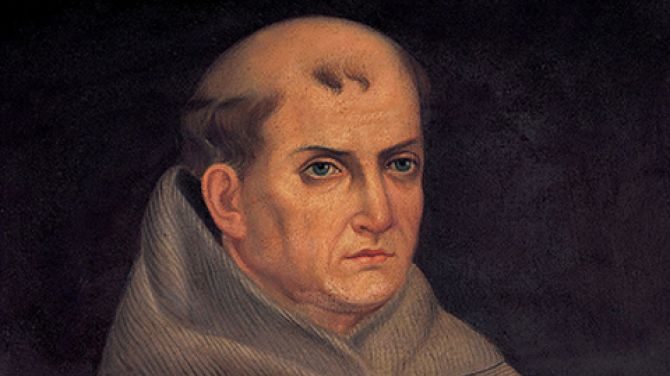St. Junípero Serra’s heroism did not change when California Gov. Gavin Newsom signed a bill to ensure that his statue will no longer stand on the state capitol grounds, Archbishop Salvatore Cordileone of San Francisco has said.
“This new law does not change the facts: Junípero Serra spent his life caring for and defending the indigenous people of California to the point of heroic virtue. Indian and Spaniard alike mourned when he died,” Cordileone said on Twitter Sept 29. “We would do well to imitate his virtues. We ignore history to our peril.”
Gov. Newsom signed Assembly Bill 338 Sept. 24. It replaced a law requiring a statue of St. Junípero Serra at the state capitol with one requiring a statue to honor local indigenous populations. The bill text claims that Serra and his missions were responsible for a host of atrocities against native peoples, which drew strong objections from Catholics who said it was inaccurate and misrepresented Serra.
Newsom signed other bills. One replaced Columbus Day with Native American Day as a judicial holiday, while another protected Native Americans who wanted to wear “items of cultural significance” at high school graduations.
The governor discussed the bill signings, saying, “Today’s action sends a powerful message from the grounds of Capitol Park across California underscoring the state’s commitment to reckoning with our past and working to advance a ‘California for All’ built on our values of inclusion and equity.”
“I’m proud to sign this long overdue legislation to honor the Native peoples who have called this land home since time immemorial and to further our important work in partnership with Native American communities to tackle the multi-faceted challenges facing California,” he said.
Assemblyman James C. Ramos, D-Highland, the author of A.B. 338, said the bill will “honor the Native people on whose land the Capitol now stands. It also allows us the opportunity to hear more about the devastating impact of the mission period on California’s first people.”
The statue of St. Junípero Serra was toppled by protesters in June 2020, at a time of many attacks on statues in the wake of protests and riots over the death of George Floyd during his arrest by a Minnesota police officer who was later convicted of murdering Floyd.
Though Ramos said he did not condone the vandalism that tore down the statue of Serra, he has previously said the action provided “an opportunity for us to explore why this figure from California’s founding has become a symbol of the enslavement and genocide for Native Americans,” the Sacramento Bee reports.
Ramos, who lives on the San Manuel Indian Reservation in southern California, says he is the first California Native American elected to the legislature. The bill to remove the Serra statue was co-sponsored by six Northern California tribes. There are over 100 federally recognized tribal nations in California.
Serra was canonized by Pope Francis in 2015. The pope praised Serra as “the embodiment of 'a Church which goes forth', a Church which sets out to bring everywhere the reconciling tenderness of God.”
“Junípero sought to defend the dignity of the native community, to protect it from those who had mistreated and abused it,” the pope said at the canonization. “Mistreatment and wrongs which today still trouble us, especially because of the hurt which they cause in the lives of many people.”
Critics of the Serra statue tended to focus on the situation of Spanish colonialism rather than on any actions of Serra himself.
Jesus Tarango, chairman of the Wilton Rancheria tribal council, said the Serra statue represented “a double injury.”
“The Miwok and Nisenan people have lived in this region since time immemorial before the hostile takeover of Native lands by settlers, land barons and gold miners who established Sacramento and the state Capitol. The statue of a figure who represents the mission period—another earlier time of genocide, slavery, and other degradations imposed upon California Indians—strikes twice at our history,” he said in a Sept. 25 statement from Ramos’ office.
Serra's missions to indigenous Californians played a critical role in the spread of Christianity. He celebrated more than 6,000 baptisms and 5,000 confirmations. Many of Serra’s missions form the cores of what are today the state's largest cities, including San Diego, San Francisco, and Los Angeles. He was particularly admired in the 20th century and various statues of him were erected on public grounds.
Archbishop Jose Gomez of Los Angeles joined Archbishop Cordileone to defend Serra in a Sept. 12 Wall Street Journal op-ed.
“While there is much to criticize from this period, no serious historian has ever made such outrageous claims about Serra or the mission system, the network of 21 communities that Franciscans established along the California coast to evangelize native people,” the archbishops said.
“We understand the bitter history of native exploitation. But history can be complicated and facts matter,” they said.
The archbishops described Serra as a “complex character,” but one who “defended indigenous people’s humanity, decried the abuse of indigenous women, and argued against imposing the death penalty on natives who had burned down a mission and murdered one of his friends.”
“The destruction of the state’s native people happened long after he was gone and many of the missions had been taken over by the government,” they added.
Cordileone and Gomez said a “war of extermination” against native Californians began more than 60 years after Serra died, under California’s first governor, Peter Burnett.

